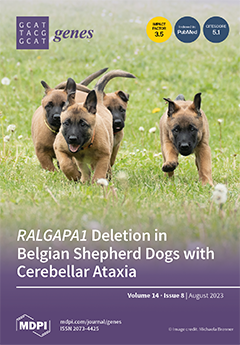Chromatin conformation, DNA methylation pattern, transcriptional profile, and non-coding RNAs (ncRNAs) interactions constitute an epigenetic pattern that influences the cellular phenotypic commitment and impacts the clinical outcomes in regenerative therapies. Here, we investigated the epigenetic landscape of the SP7 transcriptor factor (
SP7
[...] Read more.
Chromatin conformation, DNA methylation pattern, transcriptional profile, and non-coding RNAs (ncRNAs) interactions constitute an epigenetic pattern that influences the cellular phenotypic commitment and impacts the clinical outcomes in regenerative therapies. Here, we investigated the epigenetic landscape of the SP7 transcriptor factor (
SP7) and Distal-Less Homeobox 4 (
DLX4) osteoblastic transcription factors (TFs), in human periodontal ligament mesenchymal cells (PDLCs) with low (l-PDLCs) and high (h-PDLCs) osteogenic potential. Chromatin accessibility (ATAC-seq), genome DNA methylation (Methylome), and RNA sequencing (RNA-seq) assays were performed in l- and h-PDLCs, cultured at 10 days in non-induced (DMEM) and osteogenic (OM) medium in vitro. Data were processed in
HOMER,
Genome Studio, and
edgeR programs, and metadata was analyzed by online bioinformatics tools and in
R and
Python environments. ATAC-seq analyses showed the TFs genomic regions are more accessible in l-PDLCs than in h-PDLCs. In Methylome analyses, the TFs presented similar average methylation intensities (AMIs), without differently methylated probes (DMPs) between l- and h-PDLCs; in addition, there were no differences in the expression profiles of TFs signaling pathways. Interestingly, we identified the long non-coding RNAs (lncRNAs),
MIR31HG and
LINC00939, as upregulated in l-PDLCs, in both DMEM and OM. In the following analysis, the web-based prediction tool
LncRRIsearch predicted RNA:RNA base-pairing interactions between
SP7,
DLX4,
MIR31HG, and
LINC00939 transcripts. The machine learning program
TriplexFPP predicted DNA:RNA triplex-forming potential for the
SP7 DNA site and for one of the LINC00939 transcripts (
ENST00000502479). PCR data confirmed the upregulation of
MIR31HG and
LINC00939 transcripts in l-PDLCs (× h-PDLCs) in both DMEM and OM (
p < 0.05); conversely,
SP7 and
DLX4 were downregulated, confirming those results observed in the RNA-Seq analysis. Together, these results indicate the lncRNAs MIR31HG and LINC00939 as possible epigenetic inhibitors of the osteogenic differentiation in PDLCs by (post)transcriptional and translational repression of the
SP7 and
DLX4 TFs.
Full article






